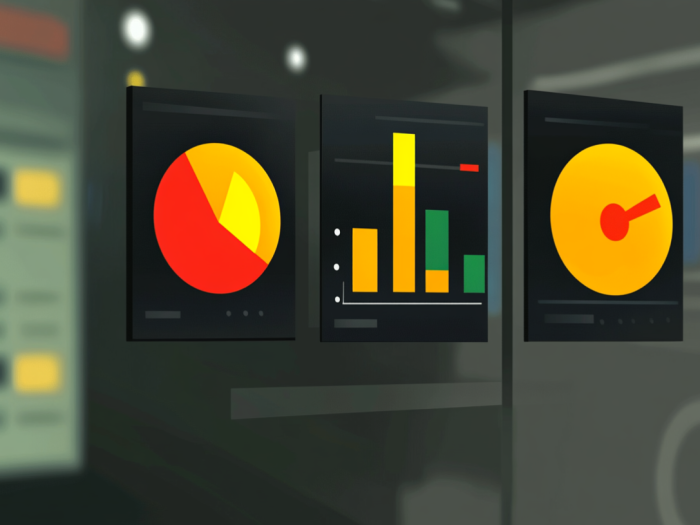Heatmap tools have become increasingly popular among traders and investors for
quickly visualizing market sector performance. These tools provide a clear
overview of which sectors are leading or lagging, enabling users to identify
potential trends and make informed investment decisions. This article explores
the best heatmap tools for identifying market sector trends and how to use them
effectively.
Understanding Heatmaps
A heatmap is a graphical representation of data where values are depicted by
colors. In the context of the stock market, heatmaps typically represent
sectors, industries, or individual stocks, with colors indicating their
performance (e.g., green for gains, red for losses).
Benefits of Using Heatmap Tools
-
Quick Visualization: Instantly grasp overall market sentiment
and sector performance. - Trend Identification: Easily spot leading and lagging sectors.
-
Relative Performance: Compare the performance of different
sectors. -
Opportunity Discovery: Identify potential trading or
investment opportunities.
Best Heatmap Tools
1. Finviz
Finviz is a popular free platform that offers a highly effective heatmap tool.
-
Key Features:
- Sector and industry heatmaps.
- Customizable color schemes.
- Various size and sorting options.
- Integration with other Finviz tools.
-
Strengths:
- User-friendly interface.
- Free access.
- Comprehensive market overview.
-
Limitations:
- Data updates may not be real-time in the free version.
2. TradingView
TradingView is renowned for its charting capabilities and also provides useful
heatmap features.
-
Key Features:
- Stock and sector heatmaps.
- Customizable timeframes.
- Integration with charting tools.
- Alerts.
-
Strengths:
- Excellent for technical analysis integration.
- Customizable and interactive.
-
Limitations:
- Heatmap functionality may require a paid subscription for full access.
3. MarketWatch
MarketWatch offers a free heatmap tool as part of its financial news and data
platform.
-
Key Features:
- Market overview heatmap.
- Sector performance visualization.
- Integration with MarketWatch news.
-
Strengths:
- Easy to use.
- Good for a quick market snapshot.
-
Limitations:
- Less customization compared to Finviz or TradingView.
4. Barchart
Barchart provides a range of market data and analysis tools, including
interactive heatmaps.
-
Key Features:
- Interactive stock and sector heatmaps.
- Customizable data fields.
- Technical indicators.
- Alerts.
-
Strengths:
- Highly customizable data display.
- Good for in-depth analysis.
-
Limitations:
- Some features may require a paid subscription.
5. Yahoo Finance
Yahoo Finance offers a basic heatmap tool as part of its free financial
platform.
-
Key Features:
- Sector performance heatmap.
- Simple visualization.
- Integration with Yahoo Finance data.
-
Strengths:
- Easy to access.
- Free.
-
Limitations:
- Limited customization and analysis features.
How to Use Heatmap Tools Effectively
-
Identify Leading Sectors: Look for sectors with strong green
colors, indicating positive performance. -
Spot Lagging Sectors: Identify sectors with strong red colors,
indicating negative performance. -
Confirm Trends: Use heatmaps to confirm trends identified
through other analysis methods. - Watch for Rotation: Observe how capital flows between sectors.
-
Consider Timeframes: Analyze heatmaps across different
timeframes (daily, weekly, monthly) to identify short-term and long-term
trends.
Conclusion
Heatmap tools are valuable assets for traders and investors seeking to identify
market sector trends. By leveraging the features of platforms like Finviz,
TradingView, MarketWatch, Barchart, and Yahoo Finance, you can gain a clearer
understanding of market dynamics and improve your investment decisions.
Remember to use heatmaps in conjunction with other analysis methods for a more
comprehensive market view.
Related Keywords
Heatmap tools, stock market heatmap, sector heatmap, market sector analysis,
Finviz heatmap, TradingView heatmap, stock market visualization, market trends,
sector rotation, investment analysis tools.
Frequently Asked Questions (FAQ)
1. What is a heatmap in the stock market?
A heatmap is a graphical representation of market data where colors indicate
the performance of sectors, industries, or individual stocks (e.g., green
for gains, red for losses).
2. What are the benefits of using heatmap tools?
Benefits include quick visualization of market sentiment, easy
identification of leading and lagging sectors, relative performance
comparison, and opportunity discovery.
3. Which platforms offer heatmap tools?
Popular platforms that offer heatmap tools include Finviz, TradingView,
MarketWatch, Barchart, and Yahoo Finance.
4. What are the strengths of Finviz’s heatmap?
Finviz’s heatmap is known for its user-friendly interface, free access, and
comprehensive market overview.
5. How does TradingView’s heatmap compare?
TradingView’s heatmap is excellent for integrating with technical
analysis and offers customizable timeframes and interactivity.
6. What is MarketWatch’s heatmap best for?
MarketWatch’s heatmap is best for getting a quick snapshot of overall
market performance and sector trends.
7. What does Barchart offer in its heatmap tools?
Barchart provides interactive heatmaps with customizable data fields,
technical indicators, and alerts.
8. What is the advantage of using Yahoo Finance’s heatmap?
Yahoo Finance’s heatmap is easy to access and free, offering a basic
visualization of sector performance.
9. How can I use heatmap tools effectively?
Use heatmaps to identify leading and lagging sectors, confirm trends, watch
for sector rotation, and analyze performance across different timeframes.
10. Are heatmap tools sufficient for making investment decisions?
While helpful for visualizing market trends, heatmaps should be used in
conjunction with other analysis methods for a more comprehensive market
view.



